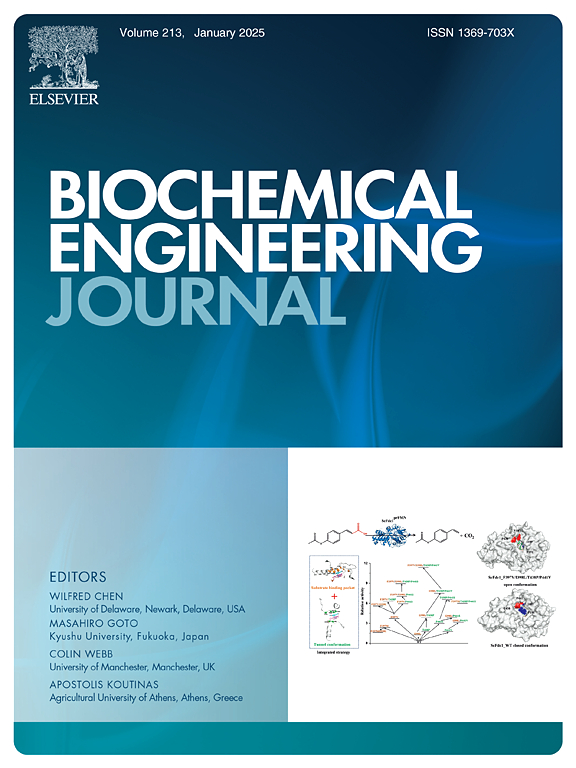Optimal dosage and recycle of cellulases for efficient biomass saccharification of cardoon and giant reed
IF 3.7
3区 生物学
Q2 BIOTECHNOLOGY & APPLIED MICROBIOLOGY
引用次数: 0
Abstract
The deployment of sugar-based biorefineries is limited by the availability of feedstocks and by the cost of enzymes. Cynara cardunculus and Arundo donax are relevant non-food crops for the development of sugar-based biorefineries. Enzymatic hydrolysis of C. cardunculus and A. donax stalks have been optimized in terms of biocatalyst dosage and reuse. Optimal utilization of a commercial biocatalyst cocktail was achieved assessing the enzyme adsorption on the biomass slurry prior to the hydrolysis stage. The partitioning of cellulases between the liquid the substrate has been characterized for raw and pretreated biomasses. Enzyme uptakes up to 18 mg/g were recorded with 5 % biomass slurries and 0.2–3 g/L initial enzyme concentrations for both C. cardunculus and A. donax. The nearly irreversible nature of the enzyme adsorption allowed a partial recovery of the unbound biocatalyst and the polysaccharides hydrolysis by adsorbed biocatalysts. In the best condition, 89 % glucans conversion was obtained in pretreated cardoon with 4 mg/g loading of adsorbed cellulases (lower than the saturation level) and in giant reed with 13 mg/g. Notably, the residual activity of the unbound biocatalyst was sufficient to hydrolyse more than 65 and 75 % of glucans in pretreated cardoon and giant reed, respectively. The proposed method can be applied routinely to any biorefinery feedstock and both commercial and in-situ produced cocktails to minimize the enzyme dosage.
纤维素酶的用量及循环利用对甜菜和芦苇高效生物质糖化的影响
糖基生物精炼厂的部署受到原料可用性和酶成本的限制。山竹和芦竹是发展糖基生物炼制的相关非粮食作物。从生物催化剂用量和重复使用等方面对玉米茎和唐菖蒲茎的酶解工艺进行了优化。在水解阶段之前,通过评估酶在生物质浆料上的吸附,实现了商业生物催化剂鸡尾酒的最佳利用。纤维素酶在液体和底物之间的分配已被表征为原料和预处理的生物质。在生物量为5 %、初始酶浓度为0.2-3 g/L的条件下,C. cardunculus和A. donax的酶吸收率均达到18 mg/g。酶吸附的几乎不可逆性质允许部分恢复未结合的生物催化剂和被吸附的生物催化剂水解的多糖。在最佳条件下,吸附纤维素酶4 mg/g(低于饱和水平)的预处理玉米和13 mg/g的芦苇的葡聚糖转化率分别为89 %和89 %。值得注意的是,未结合的生物催化剂的剩余活性足以水解预处理芦苇和芦苇中的葡聚糖,分别超过65%和75% %。所提出的方法可以常规应用于任何生物炼制原料和商业和原位生产的鸡尾酒,以尽量减少酶的用量。
本文章由计算机程序翻译,如有差异,请以英文原文为准。
求助全文
约1分钟内获得全文
求助全文
来源期刊

Biochemical Engineering Journal
工程技术-工程:化工
CiteScore
7.10
自引率
5.10%
发文量
380
审稿时长
34 days
期刊介绍:
The Biochemical Engineering Journal aims to promote progress in the crucial chemical engineering aspects of the development of biological processes associated with everything from raw materials preparation to product recovery relevant to industries as diverse as medical/healthcare, industrial biotechnology, and environmental biotechnology.
The Journal welcomes full length original research papers, short communications, and review papers* in the following research fields:
Biocatalysis (enzyme or microbial) and biotransformations, including immobilized biocatalyst preparation and kinetics
Biosensors and Biodevices including biofabrication and novel fuel cell development
Bioseparations including scale-up and protein refolding/renaturation
Environmental Bioengineering including bioconversion, bioremediation, and microbial fuel cells
Bioreactor Systems including characterization, optimization and scale-up
Bioresources and Biorefinery Engineering including biomass conversion, biofuels, bioenergy, and optimization
Industrial Biotechnology including specialty chemicals, platform chemicals and neutraceuticals
Biomaterials and Tissue Engineering including bioartificial organs, cell encapsulation, and controlled release
Cell Culture Engineering (plant, animal or insect cells) including viral vectors, monoclonal antibodies, recombinant proteins, vaccines, and secondary metabolites
Cell Therapies and Stem Cells including pluripotent, mesenchymal and hematopoietic stem cells; immunotherapies; tissue-specific differentiation; and cryopreservation
Metabolic Engineering, Systems and Synthetic Biology including OMICS, bioinformatics, in silico biology, and metabolic flux analysis
Protein Engineering including enzyme engineering and directed evolution.
 求助内容:
求助内容: 应助结果提醒方式:
应助结果提醒方式:


